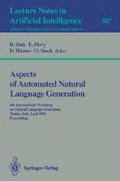Abstract
This paper introduces the phenomena of transparently-motivated metaphor. It makes a case for its prevalence, and reports analysis of some of the textual goals that such metaphor can achieve. General principles that can explain many of the uses of metaphor are discussed. Our analysis of metaphors and the resulting principles have led to preliminary developments of a methodology for generating transparently-motivated metaphors that can account for metaphor generation from general principles. This methodology allows for novel metaphor generation, an account of the conceptual structures behind such expressions, as well as an account of the effects of the metaphors.
This work is supported by Grant #H133E80015 from the National Institute on Disability and Rehabilitation Research. Support has also been provided by The Nemours Foundation.
Preview
Unable to display preview. Download preview PDF.
References
Anderson, R. C.: Inferences about word meanings. In Graesser, A. C. and Bower, G. H., editors, Inferences and Text Comprehension (1990)
Black, M.: Models and Metaphors. Cornell University Press, Ithica, NY (1962)
Black, M.: More about metaphor. In Ortony, A., editor, Metaphor and Thought. Cambridge University Press, Cambridge (1979) 19–43
Borkowski, J. G. and Eisner, H. C.: Meaningfulness and abstractness in short-term memory. Journal of Experimental Psychology 76 (1968) 57–61
Carbonell, J. G.: Metaphor: An inescapable phenomenon in natural language comprehension. In Lenhart, W. and Ringle, U., editors, Strategies for Natural Language Processing, Lawrence Erlbaum Associates, Hillsdale, NJ (1982) 415–434
Cornell Way, E.: Knowledge Representation and Metaphor. Kluwer Academic Publishers, Boston (1991)
Dukes, W. F. and Bastian, J.: Recall of abstract and concrete words equated on meaningfulness. Journal of Verbal Learning and Verbal Behavior 5 (1966) 455–458
Elliot, L. B.: The bandwagon blues AI Expert 6:5 May (1991) 11–13
Fass, D.: met*: A method for discriminating metonymy and metaphor by computer Computational Linguistics Journal 17:1 March (1991) 49–90
Fass, D. and Wilks, Y.: Preference semantics, ill-formedness and metaphor. American Journal of Computational Linguistics 9:3–4 July–Dec (1983) 178–187
Gentner, D.: Structure-mapping: A theoretical framework for analogy. Cognitive Science 7:2 (1983) 155–170
Gibbs, Jr., T. W.: Understanding and literal meaning. Cognitive Science 13 (1989) 243–251
Gorman, A. M.: Recognition memory for nouns as a function of abstractness and frequency. Journal of Experimental Psychology 61 (1961) 23–29
Jacobs, P. S.: A Knowledge-Based Approach to Language Production. PhD thesis, University of California at Berkeley Computer Science Division Report (1985)
Johnson, M.: The Body in the Mind: The Bodily Basis of Reason and Imagination. University of Chicago press, Chicago (1987)
Jones, M., Demasco, P., McCoy, K., and Pennington, C.: Knowledge representation considerations for a domain independent semantic parser. In Proceedings of the 14th Annual Conference RESNA, Kansas City, MO (1991) 109–111
Keenan, E. L.: In Shopen, T., editor, Language Typology and Syntactic Description, volume 1: Clause Structure. Cambridge University Press, Cambridge (1985)
Kittredge, R., Polguere, A., and Goldberg, E.: Synthesizing weather forecasts from formatted data. In Proceedings of Coling86 (1986) 563–565
Kukich, K.: Design of a knowledge-based report generator. In Proceedings of the 21st Annual Meeting of the ACL Cambridge, MA June (1983) 145–150
Lakoff, G.: Women, Fire and Dangerous Things What Categories Reveal About the Mind. University of Chicago Press, Chicago (1987)
Lakoff, G. and Johnson, M.: Metaphors we live by. University of Chicago Press, Chicago (1980)
Martin, J. H.: A Computational Model of Metaphor Interpretation. Academic Press (1990)
McCoy, K., Demasco, P., Jones, M., and Pennington, C.: Applying natural language processing techniques to augmentative communication systems. In Proceedings of the 13th International Conference on Computational Linguistics, Helsinki, Finland (1990)
McCoy, K. F.: Generating context sensitive responses to object-related misconceptions. Artificial Intelligence 41 (1989) 157–195
Norvig, P. and Lakoff, G.: Taking: A study in lexical network theory. In Proceedings of the 13th Annual Meeting Berkeley Linguistics Society (1987) 195–206
Paivio, A.: Paired-associate learning and free recall of nouns as a function of concreteness, specificity, imagery, and meaningfulness. Psychological Reports 20 (1967) 239–245
Paivio, A.: Psychological processes in comprehension. In Ortony, A., editor, Metaphor and Thought Cambridge University Press, Cambridge (1979) 150–171
Paivio, A., Yuille, J. C., and Madigan, S.: Concreteness, imagery, and meaningfulness values for 925 nouns. Journal of Experimental Psychology 76:{bd1} (1968) Monograph Supplement part 2
Richards, I. A.: The Philosophy of Rhetoric. Oxford University Press (1936)
Singer, M.: Psychology of Language. Lawrence Erlbaum Associates, Hillsdale, NJ (1990)
Stoke, S. M.: Memory for onomatopes. Journal of Genetic Psychology 36 (1929) 594–596
Tourangeau, R. and Sternberg, R. J.: Understanding and appreciating metaphors. Cognition 11 (1982) 203–244
Weiner, E. J.: Solving the containment problem for figurative language. International Journal of Man-Machine Studies 23 (1985) 527–537
Author information
Authors and Affiliations
Editor information
Rights and permissions
Copyright information
© 1992 Springer-Verlag Berlin Heidelberg
About this paper
Cite this paper
Jones, M.A., McCoy, K.F. (1992). Transparently-motivated metaphor generation. In: Dale, R., Hovy, E., Rösner, D., Stock, O. (eds) Aspects of Automated Natural Language Generation. IWNLG 1992. Lecture Notes in Computer Science, vol 587. Springer, Berlin, Heidelberg. https://doi.org/10.1007/3-540-55399-1_16
Download citation
DOI: https://doi.org/10.1007/3-540-55399-1_16
Published:
Publisher Name: Springer, Berlin, Heidelberg
Print ISBN: 978-3-540-55399-1
Online ISBN: 978-3-540-47054-0
eBook Packages: Springer Book Archive

